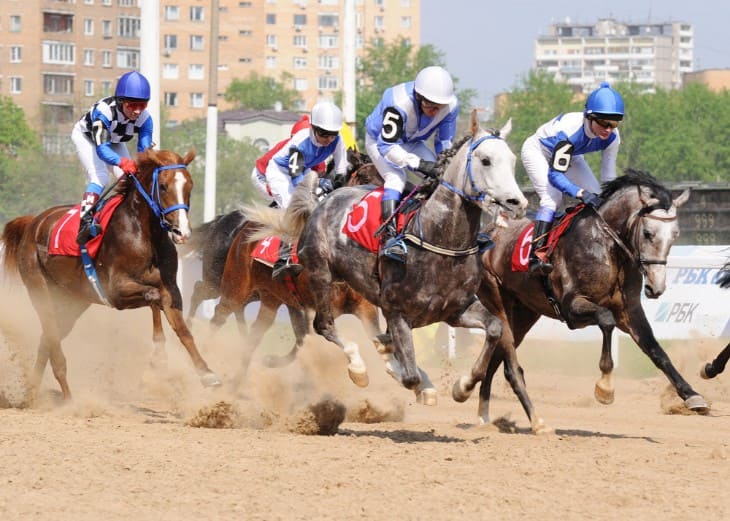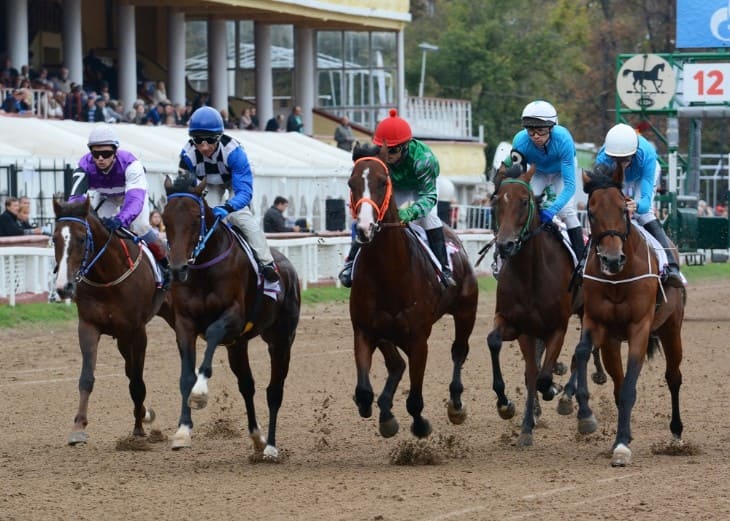- Understanding the Basics of Racing Handicapping
- The Role of the Handicapper in Racing
- Factors Influencing Racing Handicapping Decisions
- The Importance of Speed Figures in Racing Handicapping
- Analysing Race Trends and Patterns
- The Psychological Aspect of Racing Handicapping
- Advanced Racing Handicapping Techniques
- The Future Of Racing Handicapping
- Final Verdict
The art of racing handicapping entails a dance with numbers, statistics, and intuition, where fans and professionals try to predict outcomes in horse races as precisely as possible. This meticulous practice is not only about picking winners; it's about realising that countless factors can determine a race's result. Let us now explore racing handicapping, its details, and how it contributes to levelling the playing field for bettors and enthusiasts.
Understanding the Basics of Racing Handicapping
By handicapping, we mean adjusting weights for every horse. All horses have equal chances to win, so gamblers can better guess who will win or place.
That's why if a horse has been successful in winning many races in a row, it will run with more weight next time. This evens out the competition since an additional burden makes this race harder for such animals. On the other hand, if a horse has not performed well lately, it may be given less weight. This allows it to compete better, which in turn increases its chance of winning.
These weights are set by people called "handicappers." They study how each particular horse has been performing recently. For example, they look at how fast they run and check who competes against them in those races. Being a handicapper isn't easy because you must know a lot about horses to decide fairly.
Knowing what handicapping means is essential for anyone interested in gambling or watching a racehorse event. We see that each race involves more than selecting the swiftest animal on earth when we learn about this aspect. They should focus on finding the correct weights to make their chosen mount better than others.
In Short, racing handicapping turns every race into a Little Puzzle. Thus, horse trainers, owners, and jockeys try to figure out who will likely win, given the weights that handicappers have chosen. This adds another layer of strategy and thrill to horse racing.
The Role of the Handicapper in Racing
The role of the handicapper is crucial in racing. These individuals decide how much weight each horse should carry during a race. They aim to ensure that every horse has an equal chance of winning. It's not easy because the handicapper's understanding of horses must be profound.
Handicappers spend hours looking at horses. They review previous races to see how well each animal performed in them. In addition, they consider how quickly a particular horse may run, what distance it was covering, and which other racers were involved then. All these details together help them set the correct weight for every horse.
A handicapper’s decision can move odds on a race board. The stronger horse can lose its position if more load is added than expected before the day. It makes betting more thrilling since some people following races' bets closely follow what the handicappers have done concerning this particular eventuality to get odds where horses truly stand any given chance against their quoted performance times.
Handicappers have to be just and correct. This affects not only the bettors but also the owners, trainers, and jockeys. A well-handicapped race is competitive and thrilling. It attracts more fans and bettors, which is great for the sport.
In summary, the handicapper sets up the race. They ensure every horse can win, making racing exciting and fair. Skillfulness, impartiality, and deep affection for horse racing are essential requirements for their work. The sport would only be as exciting and even-handed with them.

Factors Influencing Racing Handicapping Decisions
Several factors influence racing handicapping decisions. Handicappers carefully consider these to ensure that races are fair and competitive. Here's a list of some of them:
- Horse's Performance: Handicappers begin by examining how horses performed in their last races. They take into account wins, losses, and the level of competition involved. For instance, a certain horse might be required to carry extra weight in its subsequent race if it has always beaten strong contenders.
- Track Conditions: The state of the race track matters a lot. While others prefer dry conditions, some horses do better on wet tracks. Handicappers take this into consideration, especially when the weather on the day of the race may affect the track.
- Distance of the Race: A horse's performance can depend on how far it runs. Some horses are sprinters who thrive best in short races, while others have the stamina to keep going over long distances. To give all horses an equal chance, handicappers adjust weights based on the distance of the race.
- Horse's Age: Younger horses may not have as much experience or strength as older ones. This means that younger horses often carry less weight than older ones, which, according to handi-capers, creates balance among the competitors.
- Jockey's Skill: A skilled jockey can make a big difference in a race. If an outstanding jockey rides a strong horse, handicappers often consider this.
- Recent Form: How well a horse has been doing lately tells much about its current condition. A good-shaped horse might get more weight, whereas one that keeps struggling on the track might be given less.
Handicappers use all this data during the decision-making process. They try to create an equilibrium so that every horse has an equal chance of winning. Owners, jockeys, and fans who place bets will find racing even more thrilling because of this.
The Importance of Speed Figures in Racing Handicapping
Speed figures play an integral part in racing handicapping. These numbers help the bettors and the handicapper know how fast horses have run in their previous races. It's simple; a higher speed figure indicates typically better performance.
Creating speed figures takes work. A horse's finishing time is modified using distance raced and track conditions. Therefore, we can fairly compare performances from different races. As an illustration, if two horses ran at the same time on the fast track, but one was slow track dashing, it would have gotten a higher speed figure than the other.
Handicappers use speed figures to allocate weights for each race. A high-speed figure consistently shown by a particular horse may lead to it carrying more weight than other participants in the race, which evens out its chances against others. That way, they ensure no single contestant enjoys an unfair advantage merely because it's faster than the others.
The pace figure is a useful tool for gamblers and assists them in quickly evaluating a horse's ability; however, it doesn't mean that the best horse is one with higher figures. Good bettors look for horses whose speed figures seem to be rising or might prove competitive under the prevailing race conditions.
Speed figures are imperative in racing handicapping. They provide an easy way of determining how good a horse is by using numbers. Handicappers adopt these numbers to ensure that races are fair and competitive. On the other hand, for those who intend to wager on these contests, speed figures give essential clues about each horse's chances.
Analysing Race Trends and Patterns
Racing handicapping essentially involves analysing race trends and patterns. This looks at individual horses’ performances to predict their outcomes. Some of these trends and patterns include:
- Seasonal Performance: Some animals perform better during different periods, while others may be less lucky due to weather conditions or how their training fits into the racing calendar. Such patterns can help inform handicappers when they want to choose whether or not a particular horse has better prospects for doing well in a race.
- Track Preferences: Sometimes horses have likes and dislikes when it comes to tracks or types of surfaces (turf vs dirt). It could be because of track surface, layout, past experiences that they have had there before, and many other things. Thus, recognizing this trait in any given horse becomes vital, especially when several entrants into such races have commendable records over specific track types.
- Jockey-Horse Combinations: The relationship between jockeys and their mounts significantly influences performance. Jocks that know precisely what buttons to push on particular horses will always get productive results out of them, unlike those who do not know which ones they should press at all times, thereby leading to consistently high achievements through proper coordination between them, implying it is a variable that must be considered in handicapping.
- Impact of Race Conditions: Outcomes can be influenced by conditions such as the weather, the condition of the track, and whether this race comes early or late in a race meeting. For instance, some horses are better off competing on a rainy day because they have outstanding performance in wet conditions, while others perform well only when fresh from rest.
The Psychological Aspect of Racing Handicapping
The psychological aspect of racing handicapping adds a unique layer to predicting race outcomes. Understanding jockeys' and trainers' mindsets and horses' temperaments can give handicappers an edge.
Jockeys and trainers bring their strategies and experiences to every race. A jockey's confidence and ability to remain calm under pressure can greatly affect a horse's performance. Similarly, trainers prepare horses for races, and their training approach and tactics can make a massive difference in the outcome of a race. Handicappers who consider these psychological factors could predict results that others might overlook.
Horses, too, have got their personality. Some are quiet and handle all of this racing day excitement well, while some could get tense or over-excited. Horses' behaviour just before a race gives clues about how they might perform. For instance, if a horse appears anxious or agitated before races, it may not perform as expected.
The mental readiness of the animal and its rider may be an equally important factor, like physical preparedness, in determining success on track. Their psychology is affected by many things, including recent changes in routines, new riders, or the atmosphere on that particular racing day. The presence of these factors enables handicappers to look for signs that the horse is ready for victory.
The psychological dimension of racing handicapping goes beyond numbers and past performances alone. It involves mentally knowing what is going through participants' minds, i.e., their mindsets toward winning. For example, this deeper perspective brings to light risks not immediately discernible through pure quantitative analysis, prompting the need for such information to be integrated into the handicapper's toolkit if they want to capitalise.

Advanced Racing Handicapping Techniques
Advanced techniques in racing handicapping provide more advanced ways of analysing races, giving them deeper insights than others and giving them an edge over others competing against them. These are examples of these advanced techniques utilised by handicappers:
- Statistical Analysis: Many modern-day handicappers resort to statistical analysis when assessing a horse's performance potential. By crunching numbers from previous races, they can identify hidden trends that could be invisible without further investigation. This means that to use this approach, a lot of data has to be analysed, including elements like speed figures, among others.
- Machine Learning Algorithms: Some handicappers use machine learning algorithms to predict race outcomes. These algorithms can process and learn from large amounts of data as they make predictions over time. Therefore, it can reveal some subtle factors that humans go unnoticed, giving a new perspective on handicapping.
- Simulation Models: Another advanced technique involves simulation models. These models can simulate races based on different variables and scenarios. Thousands of simulations are usually done so that the results may be seen in line with how a race might have unfolded under other circumstances. This method helps understand the potential impact of various strategies and external factors on a race's outcome.
- Proprietary Systems: Some experienced handicappers develop proprietary systems for evaluating races. Essentially, these systems marry classic forms of handicapping with personal insights and sophisticated analytics. The primary goal is to create a unique approach that ensures constant identification of the best-value bets or winning horses on the track.
With such advanced techniques, handicappers will move beyond traditional methods to find fresh angles and insights. Although these approaches need more developed tools and a more profound understanding, they significantly improve accuracy in horse racing forecasts, thus making handicappers more competent in racing development activities.
The Future Of Racing Handicapping
The future of racing handicapping is encouraging and will likely become more complicated due to technological advancements. The sport will be further exciting as we proceed in the direction where handicappers analyse races and develop predictions.
One main change that can happen is the increased usage of data analytics and machine learning. These technologies can process huge amounts of data fast, which was previously unimaginable. Factors such as slight weather changes, track conditions, or a horse's health could enable handicappers to make accurate predictions on the outcome.
Additionally, virtual reality (VR) and augmented reality (AR) may cause significant changes in how race is studied for handicappers. Can you imagine being able to see a race from a jockey’s perspective or any other point? This can provide new angles for evaluating a horse’s readiness while making handicapping richer in detail.
Social media and the internet have also started playing more significant roles. Information about races, horses, jockeys, etc. has never been available before. This wealth of information allows for better predictions and strategies based on the bookies' most recent news and tendencies.
Lastly, blockchain technology and cryptocurrencies might bring new betting platforms and secure ways of tracking a horse's lineage or its previous performance history. Consequently, bringing more transparency to betting within the horse racing industry attracts more participants.
Final Verdict
In conclusion, racing handicapping is an intriguing combination of science, intuition, and strategy. It demands thorough knowledge about the game and its players and detailed observations. For experts with years of experience or just rookies wishing to explore something interesting about it, racing handicapping provides unending opportunities for discovery.
The spirit behind every good race involves fair play and excitement when placing bets, leading to competition among participants, which determines quality results as expected in this intricate yet fulfilling exercise accomplished through careful consideration of processes involved towards fairness in all aspects related to Horse Racing always leading up onto each individual associated with every race thereby making sure that skills & dedication are put into practice.







